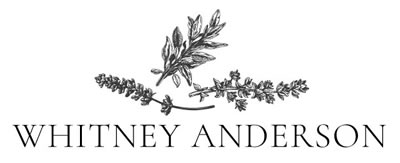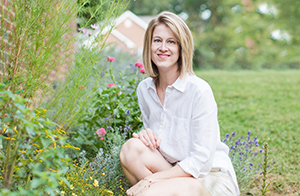We went on a tour with Conciencia Tours & Travel to the Coba ruins, Tamcach Ha Cenote, lunch with a Mayan family and a visit to Punta Laguna monkey reserve. Our guide, Miguel, was fantastic. We were blown away by his knowledge of everything to do with Mayan culture, history, the Coba ruins and the ecosystem in this part of the country.
Coba
We went to Coba first thing in the morning, which is a great idea to avoid the crowds and beat the heat. Coba was a large Mayan city between two lagoons that was settled between 100 BC and 100 AD.
After entering the site, we hopped on bikes and took off to Nohoch Mul, the largest temple pyramid at Coba.

I was shocked when we turned the corner on the jungle path and this came into view — it was MUCH bigger and taller than it looks from photos. Nohoch Mul is one of the only temple ruins that you are allowed to climb.
I was excited to climb it the 138′ temple, but a little nervous as I haven’t done anything too strenuous since my surgery. I felt very out of shape going up, stopping to huff and puff. But, I enjoyed doing it and the jungle view from the top was pretty cool.
The trip down was a bit scary looking, so I went down on my butt step by step most of the way.

We went to the Tulum ruins last year (very early in the morning) but still it was SO hot. Here, much to my delight, much of the time you are in the shade and when you’re on the bike, you’re getting a little breeze, so it’s a more enjoyable experience.
The ball courts were interesting. The ball game played an important role in Mayan society and most cities had a ball court, which is basically a corridor of two stoned walls. The game was played between two teams, using only their hips and elbows to get a rubber ball through a hoop. At some sites, like Coba, the sides of the ball court are slanted, which makes it possible to get close to the hoop. In other places, like Chichen Itza, the hoops are situated high up on almost vertical walls, seemingly making it impossible to score. It is thought that human sacrifice was a part of the game somehow.
The skull was a symbol of Mayan fertility, representing the circle of life.
We saw a bunch of vultures land at top of one of the temples and they just stayed there with their wings spread.
On our way out, we got some fresh squeezed juice and it tasted so good. Not sure why, maybe because I was hot and tired, but it was pretty darn good.
Cenote Tamcach Ha
After climbing Nohoch Mul, it was a perfect time to go dive into a cool cenote. Cenotes are everywhere in this part of the country and they are like collapsed sinkholes or caves with fresh water pools. Many of them connect and the most adventurous divers go from one to the next.
It’s so cool because usually there’s just a hole in the ground…sometimes with steps, sometimes a ladder, sometimes you have to rappel.

This one had a huge spiral staircase going down, down, down.

We visited two last year and it was just as amazing this time as well. The water is so crystal clear and so blue. You can see every rock below the water.
Tamcach Ha is gorgeous. It has two platforms that you can jump from — one that’s 16 feet (5 meters) and one that’s 32 feet (10 meters). That’s a long way down! 😮 Erick jumped off of the 16 foot platform and said it was exhilarating.

I dove in from the bottom and that was plenty exhilarating for me. The water is so cold and so refreshing.
Watch our video and watch Erick jump:
Mayan Farm and Lunch with Mayan Family
Next, we went to the visit a nearby Mayan town, specifically Enrique’s farm and home. It was a great experience to visit a real community, not some staged spectacle for tourists. These are real people in a real town and we were amazed by their hard work and tenacity to be able to farm an unforgiving rocky landscape. Enrique is the pioneer in this community and his farm was somewhat of a pilot program and now other families have seen what he has done and will follow suit. After a snack of fresh marinated cucumber at the farm, we continued on to his home, where his wife prepared a delicious lunch of chicken pibil, hand patted tortillas, rice, beans, etc. We enjoyed goofing around with his young daughter, Jimena, and she was fascinated with our GoPro and didn’t want to give it back.
When we left and got on the main road through this community, we saw three school children in uniforms on the road trying to hitch a ride. Our guide asked our driver to pull over and we picked them up and drove them several miles down the road. This road was a very narrow two lane road with absolutely no shoulder on either side — the jungle just creeped over on both sides into the road. We were amazed that these kids had so far to walk on a hot, sunny road — not the side of the road, on the road. It’s a huge commitment for them to go to school. We saw the school and it was like a two room schoolhouse with a playground. This community has 197 citizens and are very proud to have their first two in college right now.
Erick with Jimena taking a GoPro selfie. 🙂
Punta Laguna Monkey Reserve
Finally, we went to Punta Laguna monkey reserve. It’s most known for its spider monkeys, but we didn’t see any that day. We did see one lone howler monkey though. This wasn’t as super cool for us because we have been to Costa Rica where the monkeys are just everywhere.
However, it was a beautiful location and I enjoyed seeing the pond where the monkeys go to drink and the crocodiles hang out. And, the lake was gorgeous. So many amazing fresh water places in this part of Mexico. Again, clear and pretty.




























No Comments